The Schenk introduced me to the world of silk screening and I’ve found that very few people understand how it works. So here’s a quick how to for silk screening.
What you’ll need:
1. A Screen, of the silk screening variety (super fine thin holes)
2. Ink (textile inks for tees)
3. A squeegee
4. Light sensitive chemicals
5. A fan
6. A photoflood light bulb (BBA #1. Apparently black light bulbs work too) in a large light mount
7. Masking tape
8. Laser printer and transparencies
9. Toothbrush
10. Screen filler
Step 1:
Apply some masking tape around the edges of both sides of your screen.
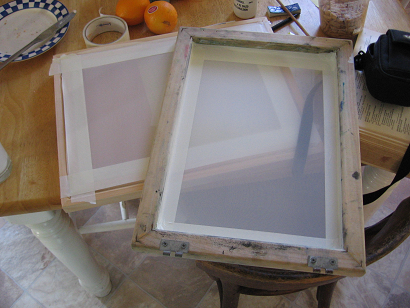
This is mainly to prevent the ink from getting between the frame and the screen and ruining your equipment.
Also, print out your design on a transparency with a laser printer. Once printed, hold it up to the light to ensure that your design is completely opaque!! you may have to run it through the printer a few times.
Step 2:
Find yourself a darkish room. Take the light sensitive chemicals and spread them on the screen with your squeegee. After you add some to one side, flip it over and add a little to the other side. Squeegee both sides until you feel the emulsion is consistent along the entire screen.
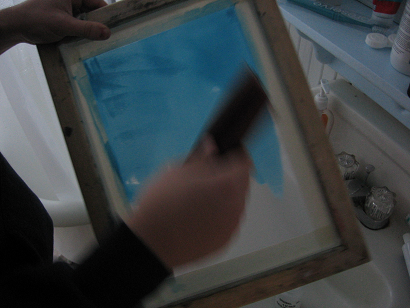
Many stores sell this type of light sensitive emulsion, but oftentimes you must add a light sensitizing agent first. Add it all, and mix well before application!
Step 3:
Prop your screen off the ground with a few books in front of a fan (on medium), in a SUPER dark room, and let it sit for an hour.
In the picture below, i was stupid because I used a flash during a light sensitive process. My idiocy is your gain because you can see the process better.
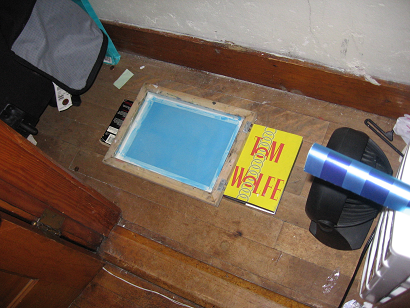
Meanwhile….
Step 4:
Lay out your shirts, canvas, posters, whatever… lay them so that they obnoxiously take up every inch of floor space in your kichen, foyer, everywhere.
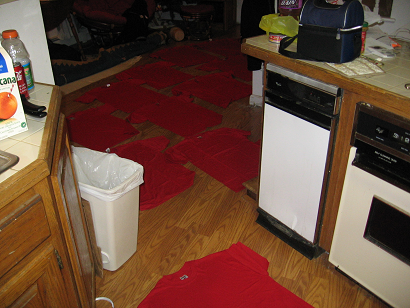
Step 5:
After an hour, enter the dark room and touch the screen. If it’s dry to the touch, you’re good to go. While in the dark, place your transparency on the screen. Depending on which side of the screen you put the transparency on, you’ll want to put it so that it reads frontwards or backwards. Think about how you’ll ink your final product before you do this step to make sure you do it right.
Center your light mount 24 inches above the screen.
Turn on the light and Blast the screen!
At this point the light from the photobulb is hardening the light sensitive chemicals. But the ink on the transparency is preventing the light from hitting the chemicals directly beneath your design so that ink will remain somewhat liquid while the rest of the screen hardens.
Step 6:
After 12 minutes, your screen should be ready. Turn off your lightbulb and remove your transparency. You should be able to see a significant difference in color between the chemicals that were under the ink and that which was exposed to the light.
While still in low light, retreat to a bathroom and put your screen under a stead cold water stream. Using a toothbrush or nylon brush, scrub the surface gently to remove the emulsion from the still liquid spots. As you scrub under the cold water the chemicals that were not hardened will come out of the screen… revealing your beautiful design! You now have a perfect crisp stencil!
Step 7:
Let the screen dry. Maybe in front of a fan.
Step 8:
Hold the screen up to a bright light and make sure that you don’t have any pinholes of light shining through the emulsion. If you do, you’ll have to paint a little screen filler (with a paintbrush) over those spots. If this is the case, let it dry for 10 minutes after painting that additional screen.
Step 9:
Put your game face on.
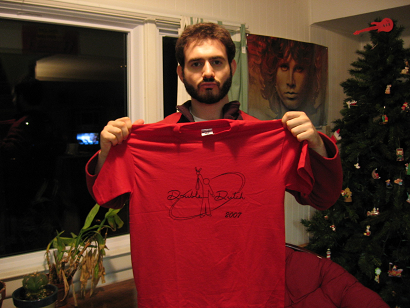
It’s printing time.
Step 10:
Lay the screen down on your canvas. Using a spoon, spoon a hefty blob of ink on one side and then, while pushing forcefully down on the screen, squeegee the ink across… once… twice… three times.
Schenk has informed me that the first pass is called the flood pass. It doesn’t really put any ink on the paper, it just populates the screen cells with ink. SO… after you ink the first object, you only need to squeegee twice on all subsequent screenings.
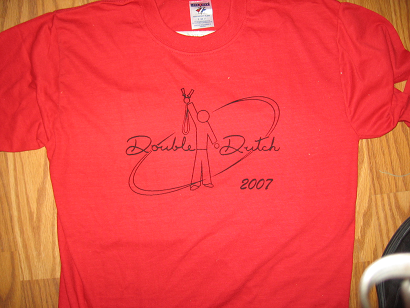
Step 11:
Unfortunately, you’re not done. The ink dries fast, so if you want to save your screen, you’re going to have to also act fast.
Once all inking is complete, get yourself to a tub or large water basin. Turn on some hot water and flush the ink out!
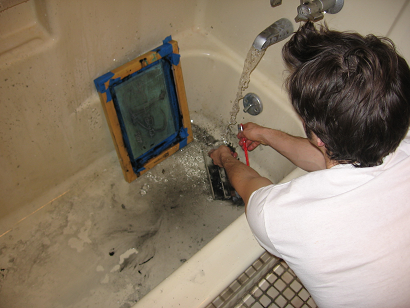
Once the ink is out soak the screen in some bleach and water and scrub with a toothbrush or nylon brush. The emulsion will come out and you’ll be left with a clean screen ready for future printings!!
Step 12:
If you’re printing on t-shirts, let the ink dry for at least 15 minutes. Then, throw the shirts in the dryer. The heat from the dryer will set the paint and your shirt will last forever.
Ryan uses the dryer move. Drew actually puts his screened shirts in the oven for a few minutes.
And that’s about it! you can get most of this gear at your local art store. If you have questions about the process, feel free to fire me an e-mail at: mikedidonato AT gmail DOT com